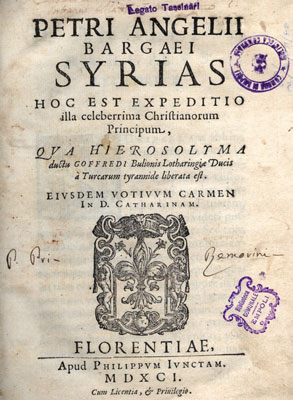 Petrus Angelus Bargaeus (1517-1592) was a scholar
and professor in Pisa and Rome.
He is also
known as Pier Angelo da Barga and Petrus Angelo
Bargeo. He provided a poem
for the book, praising Ponce de Leon and recommending
the book to the reader.
Petrus Angelus Bargaeus (1517-1592) was a scholar
and professor in Pisa and Rome.
He is also
known as Pier Angelo da Barga and Petrus Angelo
Bargeo. He provided a poem
for the book, praising Ponce de Leon and recommending
the book to the reader.
Among other things, Bargaeus wrote Commentarius de obelisco, published in Rome in 1586, of which Edward Gibbon says in The History of the Decline and Fall of the Roman Empire, Chapter XIX, note 46: "... the learned, though confused, Dissertation of Bargaeus on Obelisks... This dissertation is dedicated to Pope Sixtus V., who erected the obelisk of Constantius in the square before the patriarchal church of St. John Lateran."
Bargaeus was also the author of Syrias: hoc est expeditio illa celeberrima Christianorum principum, published in 1591.
Pope Benedict XIV, in an encyclical of June 26, 1749 (On Preparation for the Holy Year) writes: "...The chief glory of Rome is that the head of the Catholic religion and the center of its unity established residence here. Because idolatry prevailed in the city for so long, it is wonderful to see how completely it has been destroyed. Scholars are acquainted with the opinion of Petrus Angelus Bargaeus in his well-known letter, de privatorum publicorumque aedificiorum Urbis Romae eversoribus, in which he tries to prove that the magnificent theatres, temples, and baths as well as the many images of idols were not destroyed by the Goths, Vandals, and other savage nations. He contends that they were demolished by the Roman Pontiffs, especially St. Gregory the Great, and others so as to remove completely from their presence all remembrance of idolatrous worship and the provocation of superstition. But whether or not this is true, he certainly succeeded in completing a laborious treatise on the profane and superstitious remains of the pagans interred in the churches. He has also named and counted the churches which were built upon the foundations of profane pagan temples; these can still be seen in Rome...."
